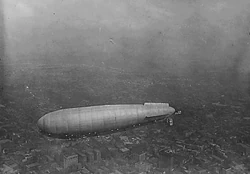After somewhat admiring the Zeppelins, the Army Air Service bought the Italian semi-rigid airship, the Roma, in 1920 for $165,000. After the Roma went into service with the Army, they had many problems with its Italian-made Ansaldo engines. The Air Service decided to replace the Ansaldo engines with Liberty engines, and the first flight of the Roma with Liberty engines was from Langley Field, Virginia on 21 February 1922. The Roma had forty-five people onboard including seven civilian technicians from McCook Field.

The roma in flight. But notice now how the ship is slightly bending, and the ruffles and wrinkles on the ship's body. This is not supposed to happen on a Semi Rigid Or Blimp.
During the flight, the nose structure of the Roma collapsed causing the elevator controls to jamb. Unable to navigate, the Roma lost altitude and settled on some high-tension power lines near the Army Supply Base at Norfolk, Virginia. Upon contacting the power lines, the Roma’s hydrogen gas exploded in an enormous fireball leaving only eleven survivors.
Design[]
The Army was short on money at the time and wanted the cheapest Ship they could get. So they turned to an inventer, Umberto Nobile. He quickly whipped up a poorly designed Semi-rigid ship, called the Roma, and the Army bought it.

The Roma taken out of her hangar for flight. Look at her design. Ouch.
It was a disaster waiting to happen, but Nobile was content about the whole thing. When he heard of the crash, he went into therapy, but recovered and went on to ride with Raold Amunson and his airship, Norge, And than to make the Italia, which was another disaster.

Notice the box-type rudder with a resemblance of an airplane. Added by the US Army, the rudder helped the doomed ship turn easier than the rudder Noble had in mind.